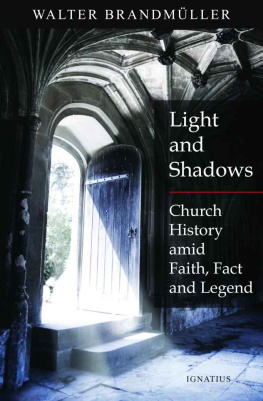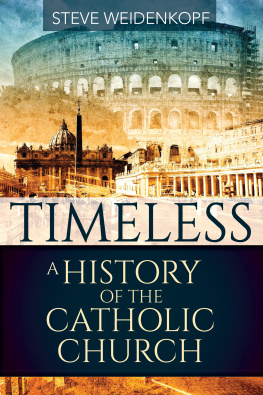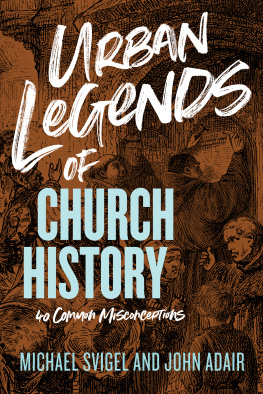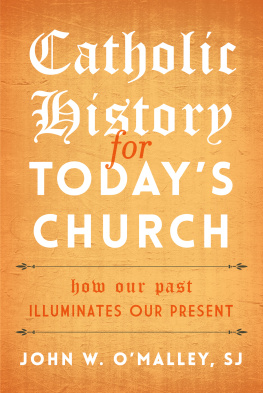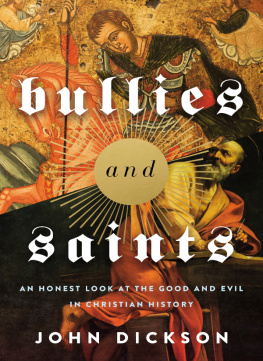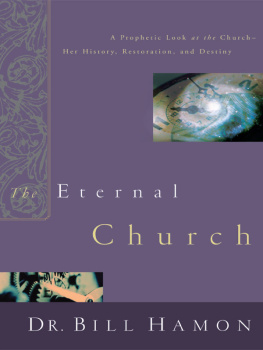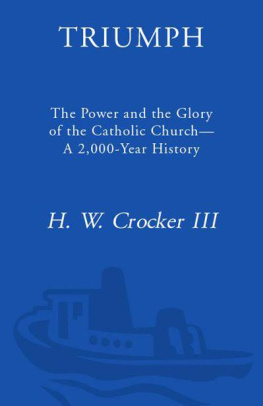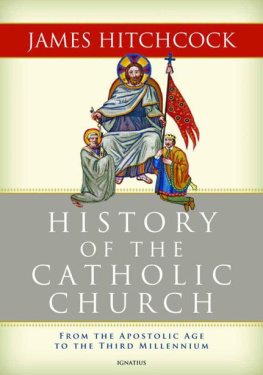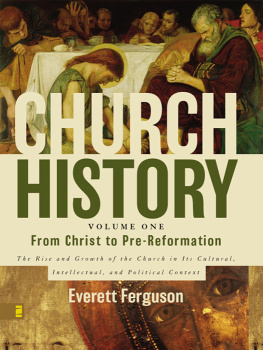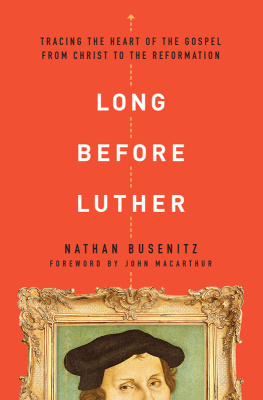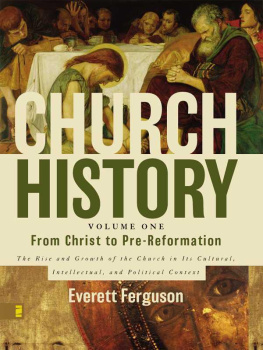WALTER BRANDMLLER
LIGHT AND SHADOWS
Church History amid
Faith, Fact and Legend
Translated by Michael J. Miller
IGNATIUS PRESS SAN FRANCISCO
Original German edition:
Licht und Schatten: Kirchengeschichte
zwischen Glaube, Fakten und Legenden
2007 by Sankt Ulrich Verlag GmbH, Augsburg
Cover photograph: James Thew / iStockphoto
Cover design by Roxanne Mei Lum
2009 Ignatius Press, San Francisco
All rights reserved
ISBN 978-1-58617-273-2
Library of Congress Control Number 2008936284
Printed in the United States of America
CONTENTS
ACKNOWLEDGMENT
The present volume is a collection of texts, revised and without the original scholarly footnotes, that were written for various occasions and published in various places.
My sincere thanks to Dr. Susanne Siegl-Mocavini and Dr. Barbara Dienst-Friedrich for their valuable collaboration in preparing the manuscript.
I
TRUST THIS CHURCH?
Occasionally the Church is compared with Noahs ark: only his sons and daughters, only those animals that Noah took with him into the ark were saved from the great flood. In a similar way, the Church is supposed to be mans only rescue from the final catastrophe.
When discussion turns to the Last Things, to mans eternal fate, then the question assumes the utmost urgency: To whom can he entrust his eternal fate and himself? What can he rely on in life and death? Now, since the Church makes the exclusive claim to be the saving ark, this claim must be so solidly established that it does not mean a leap into uncertainty when man puts his trust in this ark.
Questions about Questions
To many of our contemporaries, such trust in the Church appears to be nothing less than an unreasonable demand upon sound common sense. Arent there countless facts (the objection goes) that demolish the credibility of the Church?
Many people have read the numerous books or seen the television programs that deal with the subject of the Qumran community and seem to offer proof that the beginnings of Jesus of Nazareth and of Christianity ought to be portrayed in a completely different way from what is recorded in the Gospels and the rest of the New Testament. Many have also seen the earthenware receptacle containing human remains that was found in Jerusalem, on which the names Joseph, Mary and Jesus were inscribed. Isnt this compelling evidence that Jesus did not rise bodily from the dead and that Mary was not taken body and soul into heaven? With that, however, the foundations of the Christian faith crumble into dust and ashes! Many people today suspect that this is so.
Furthermore, the Churchas they saythrough clumsy errors made by her official teaching authority on numerous occasions, has repudiated her claim to hold the truth infallibly. Let us listen to Hans Kng, who lists the classic errors of the Churchs Magisterium, most of which have been admitted. First he mentions the excommunication of the Ecumenical Patriarch of Constantinople, Photius, and of the Greek [Byzantine] Church, which formalized the soon-to-be millennial schism with the Eastern Church. Then Kng adduces the prohibition against charging interest [on loans] at the beginning of the modern era, whereby the Churchs Magisterium changed its opinion much too late, after various compromises. Then (what else could you expect?) he also cites the trial of Galileo in 1616 or else in 1633 and other things of this sort. The most recent major error of the Magisterium, in his view, is its rejection of artificial contraception.
Others before and after him have pilloried the Church on account of the Crusades, the Inquisition and the witch trials, and anyone who is still not satisfied is referred to the financial scandal of the Vatican Bank and the murder conspiracy against Pope John Paul I, who was so likeable: Mafia in the Vatican, at the heart of the Church. From another corner the cry is that a power-hungry clique of Freemasons already replaced Paul VI with a double whom they could control and that the Lodge in general seized power in the Vatican long agoand so on. Therefore, who can still trust such a Church?
If you are really going to ask the critical question about reliability, however, then direct it not only at the Church but also at the objections that are raised against her.
Justified Criticism?
The Qumran Theme
The most popular books about Qumran, The Dead Sea Scrolls Deception by Baigent and Leigh, and Jesus und die Urchristen [Jesus and the Early Christians] by Eisenmann, as well as other comparable publications on this topic, have been exposed by serious researchers as clumsy concoctions. The books are partly the result of scientific incompetence; to some extent they are based on deliberate, malicious falsification of the facts. It is precisely the archaeological findings at Qumran that, quite to the contrary, shed an extremely interesting light on the New Testament and even clear up riddles. And as for the ossuary with the names of Joseph, Mary and Jesus [Joshua], which actually comes from Jerusalem and dates back to the time of Jesus, the names mean nothing at all, when you consider that they were as common and therefore as insignificant as the names Miller, Fields and Smith would be today.
Similarly, with regard to Hans Kngs errors of the Churchs Magisterium, we are dealing more with the errors of Hans Kng than with those of the Church. First of all, in page after page, he confuses Patriarch Photius with Patriarch Michael Cerullarius. Then Kng fails to mention that Photius was excommunicated because he had become Patriarch in an unlawful manner and furthermore had accused Rome of heresy and had tried to depose Pope Nicholas I by means of a manipulated synod. Depending on how one views the particular historical circumstances of this case, one could possibly speak about a wrong decision in ecclesiastical politics or an unjust excommunication, but never about an error of the Churchs Magisterium.
The same is true for the prohibition against lending at interest and its gradual abolition by the Church. This prohibition against charging interest was based on the Old Testament and had been confirmed by popes and councils. Why this was so becomes clear when you consider that in antiquity and in the medieval world, charging interest was most often identical to usury. Lending at interest lost this sinful character, however, with the transformation of commercial structures in the late Middle Ages. Thus the reason for the prohibition against charging interest became moot over the course of time, and from then on the only concern was with the question of determining the just rate of interest. The general prohibition had thereby become null and void. So where in all this is there an error of the Churchs Magisterium?
The condemnation of Galileos teaching about the fixed position of the sun and the movement of the earth, which is also so often described as an error of the Churchs Magisterium, proves upon closer inspection to have been justified at the time. With the scientific methods at his disposal, Galileo could not offer a proof that would convince the specialists either of his day or of ours that that is really the case, nor could he explain, before the discovery of gravity by Isaac Newton, how the earth could possibly revolve at breakneck speed around the sun and around its own axis while at the same time nothing of the sort is perceived by us, since everything on earth stands firm and secure instead of being tossed about in a tumultuous whirl. Most importantly, though, the whole legal proceeding against Copernicus and Galileo resulted in not one single magisterial statement that could have been described as a dogma and on that account would have been irrevocable. In this case, too, the critics fail to take into consideration the many events and facts in intellectual, cultural and scientific history that explain this decision. Furthermore, the most recent scientific findings vindicate the Church of 1633.

